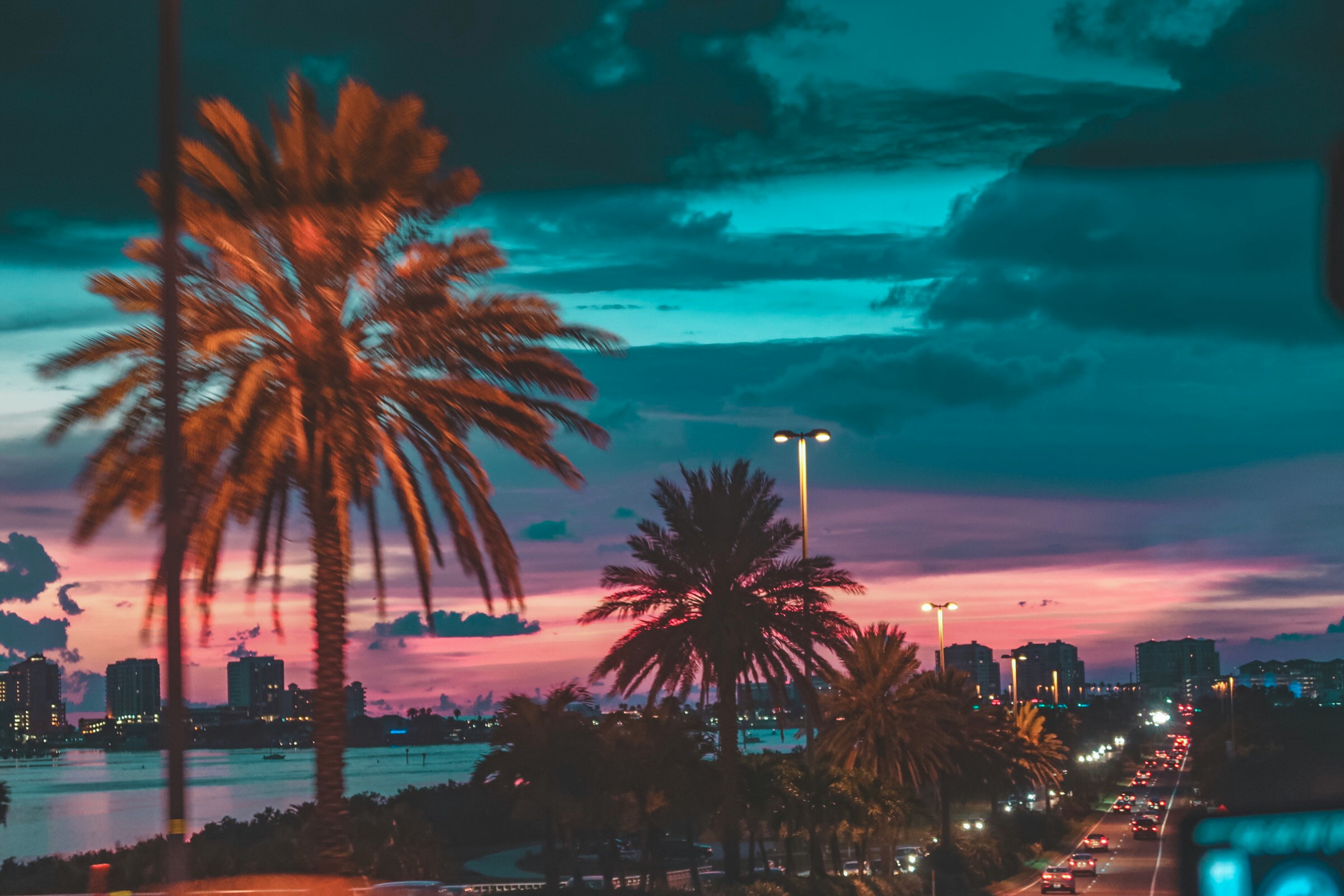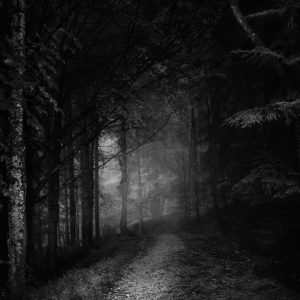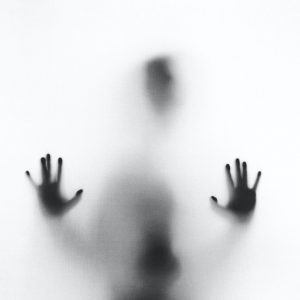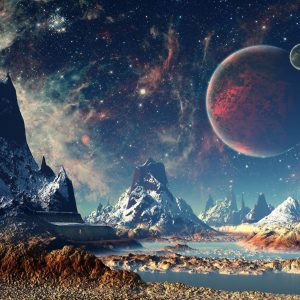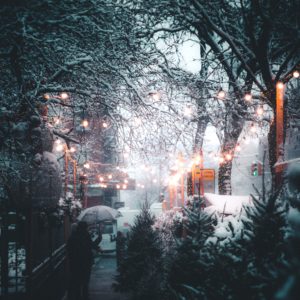The coldness of space clings to the alien ship. It lands where earth-moving machines disemboweled a humid Florida swamp rich with the nests of birds whose feathers were an iridescent white, whose feathers lifted into waves of lace. The birds are gone from here now. Instead, soil is piled high and flat to form the illusion of stable land around the sunlit gleam of a picture postcard-perfect lake. On the far shore, the scaffolding of Cinderella’s castle rises.
The landing force of the ship liquifies the sand, and water covers the grid of paved roads laid out between concrete pads set in place for construction. The billboard of an entrance sign collapses. The words “Future Home of Disney’s Polynesian Village Resort” hang down to the ground. “Coming in 1971” wrinkles under the shallow water.
Inside the ship, waves of their viscous atmosphere buffet the beings secured in their cocoons. They wait. The ship tilts and shifts again and again, and the walls groan. As always, their emotions travel through each other, carried by the syrupy substance they live within. A corner of the ship drops hard, and a spike of terror accompanies the shriek of metal ripping. Then it quiets. The calmest of them soothe the others. The boldest lead them to emerge from the cocoons.
The ancestral euphoria soars. Their elation reflects and strengthens among them and deepens into a fathomless empathy. This communal connection defines their race. The beings glide to their assigned places and perform the ritualized procedures they’ve drilled themselves in all their lives: the instructions for this moment when they land on a new planet. Some deploy stabilizers without knowing what they are, only that the stories describe a Great Balancing. Others turn off the engine, and a sudden loss of the unending vibration might have shattered their minds if the Great Stillness had not been foretold. They left a dying planet so long ago that their history and their science have become myths. What remains of their race is here on this ship, on this new planet. It’s the end of their journey, and the excitement of a new beginning trembles through them. The excitement shifts to fear when an orange glow of alarm spreads the information of a crack in the skin of the ship.
Eons of the Earth’s dead are interred in the soil and water below the ship. They have never noticed the activities of the living. But now, a disturbing stream of unknown molecules and peculiar cast-off flecks of tissue hiss into their awareness. Atoms of old stars fall into the muck of soil. This provokes the dead. The dust of a massive femur remembers traveling the wide prairies of a parched Florida. It remembers racing with the other mastodons and their children to escape the fires set by hunters. She remembers the way she bellowed as they all died, ambushed by a line of spears.
Within the compressed soil under a concrete pad, the cattle rancher bristles against the star dust. The force of the landing tumbles the bones of her children close, and she tucks them behind the protection of her skeletal ribs. She bore eleven children, but only four of them lived to adulthood. She arrived as a bride from Cuba with a dowry of money and pride, and all her life, she protected her family from outsiders and foreigners as if she weren’t those things herself. When her husband died, she’d been the one to chase remnant bands of Seminole south, off the land she’d taken from them, and she oversaw the breeding of both scrub cattle and tougher horses. She herself had negotiated the beef sales to both Union and Confederate armies, which meant her living children inherited a wealth that had lasted forward through generations. These beings with the terrible smell of their leaking atmosphere and the assault of unwanted emotion—the yearnings, the compassion—repel her.
More of the dead, both ancient and fresh, quicken. The retired field biologist is still warm. Last winter, in his northern home, he’d had to make the choice between propane and food, so he’d chosen alcohol instead. When spring came, and he was still alive, he decided to never be cold again. The Florida trailer park retirees mark the boundaries of their tiny yards with bamboo mats weighed down by potted plants. They decorate with American flags. His plan had been to sit among them and drink himself to death in the sun. But walking to the grocery store along a road with drainage ditches to either side, he’d noticed how he now lived in a place where just a six-inch change in elevation transformed an ecosystem. That intrigued him as much as mountains ever had.
The biologist had left the trailer park and explored the construction site. He’d observed the destruction of swamp and forest. He’d discovered that on Sundays, the watchman didn’t show up until the afternoon. The biologist understood about hangovers. So Sunday mornings were when he roamed the site to take water level measurements and count the remaining birds and frogs. This Sunday, he’d been documenting a plant species already establishing itself at the newly created shoreline when the spiraling scream of metal made him look up. A few seconds later he was thrown back as the ship landed. He’d had an airborne moment of scientific enthrallment before his head slammed onto the concrete pad that covered the cattle rancher and her children. His skull cracked. A cloud of grace had spread from the alien ship to hold him as he died.
The ship’s weight continues to intrude on a water table that lurks close to the surface and is always ready to flood the newly-created land. The pressure removes the protective swaddling of peat from around the young woman’s preserved skull, and brain tissue sparks into a shared sentience with the other dead and the alien beings. She remembers how her people were on their seasonal move to the coast when she died. She hadn’t remembered a few weeks ago when her water-buried, peat-preserved bones, organs, clothing, and her mother’s gourd were dredged to the surface by the bucket of an excavator. The construction manager had been called over to look at her. He knew enough to know the remains were ancient. “Cover that back up, quick, before any of those damn archeology people shut us down.” And she was interred back away from the oxygen that was causing her to disassemble.
But this time, in the company of the other dead, she remembers her brother. For the first time, he’d been old enough to take a turn pulling her litter, and she remembers watching his new bulk of muscle flex down his legs. Her own legs were strong enough to walk with the help of sticks, but when they traveled, she wasn’t fast enough to keep up. Even when she wasn’t sick, it was better for everyone if she let them pull her. The open place in her spine she’d been born with had never become that infected before; she’d never been that thin, that much in pain. Her brother hid his worry by teasing her about how heavy she was. She tried to tease back by saying he was still a weak baby of a boy, but her voice was filled with fever, and the fragile whisper made her brother call out. He had untied the fabric rope from around his waist to set down the litter. She’d woven that rope on her travel loom.
She doesn’t know that the weavings she created and her people traded would be found a decade from now in a burial ground also preserved by Florida peat. That scraps of her work will exist in an environmentally-controlled chamber set at 35 degrees Fahrenheit with a humidity of 55% and treated with 1% ortho-phenylphenol in ethanol and deionized water and then maintained in a frozen state of -11 degrees. That both archeologists and modern weavers will wonder at the rarely-seen use of three-weft twining. They speculate it made the fabric stronger. The young woman liked how it left decorative ridges.
Her brother had called over their mother, who squatted beside the litter. She tilted a gourd to her daughter’s lips. The young woman could smell the nightshade added to the elderberry, which was already an ache in her stomach. It would be of no help if she vomited. She kept her lips shut. She put a hand up on her brother’s vest and grasped the palmetto frond fringe that hung from the bottom. She’d made this for him as his growth blossomed. The fabric was soft and flexible. She admired her work. Her last memory was her mother’s palm cupping her neck. She had lived, cared for, and contributed to her community for sixteen years. Which she doesn’t know is longer than most children with spina bifida survive these six thousand years later. The alien beings are remembering with her and admire the practical kindness of her people’s culture.
When the alien presence animates the sugar cane worker, his final despair is still with him. He died worried about his family. Would his wife think he abandoned her and their children back in Jamaica for a new family in Florida? He prays they knew he was dead. The spiral mesh of the rattlesnake’s skeleton is still wrapped around his ankle. He’d tried to stay alive. He knew not to complain. He’d seen the old bones left to rot in the muck between the furrows. Tales were told of the American Blacks who worked the fields before the Jamaicans came. That labor trains stopped for them in small towns and promised the Blacks work in the Everglades but didn’t tell them they could never leave. When they tried, the bosses beat them or killed them and left their bodies exposed as a warning. But war against the Nazis saved some of them. They enlisted. After the war, in a racist delusion, the bosses waited for their return. When instead they traveled north to the factories, the white men imported Jamaicans like him. It was a good-paying job if you started from starving and if you knew how to handle a machete.
It wasn’t the bosses who had caused him to run. It was gambling. He’d always been weak in that way, and the lonely boredom and terrible labor of cutting cane wore him down. Men came to collect for the final time, and he’d run out into the night and kept going. He’d run for days. He’d run until his final step crushed the body of the snake, who died as it struck.
All of the disrupted dead startle into a joined alertness when the ship opens a portal. A being emerges. The rattlesnake thinks it looks like one of her own just hatched. That size, but instead of a tail that vibrates against the sand, the small being has tendrils at the top end. The dead watch the tendrils stretch and thin and then collapse. The small body falls. Both the dead and the aliens waiting inside the ship feel the pressure of Earth’s gravity and a barren atmosphere too empty to sustain life. A profound agony explodes through the walls of the ship. As far away as Orlando, cars swerve and bump onto their shoulders as their drivers are stuck down by a desolation that blurs their vision.
The sugar cane worker is the first to react. He remembers his children. The small being must not die separated from its family. He throws his essence around it and tries to be a buffer against the pressure of an unfamiliar gravity. The biologist imagines himself a seal over the ship’s leak and this becomes so. The escaping substance reminds him most of a liquid and a surge of agreement comes from inside the ship. The sugar cane worker understands and scoops water inside the cocoon. The small being plumps.
The cattle rancher screams out her anger. If one lives, they will all live. This is our land. They don’t belong. Let them die. Her ribs shake around her children, and she chooses to forget that she was once the invading force. The ship settles again. This time it breaks open a layer of clay that has served as a reliquary for the arm bone of a Calusa man. It has traveled from South Florida in stages: a play toy dug up by young foxes, floating inland from the floods of summer thunderstorms, and spun into the air by a hurricane until it sank into this former swamp.
The bone still retains the bulk of a warrior and the length of his tall people. It bursts through the ground in support of the cattle rancher. Kill them. Every single one. Kill them while they are few and weak. That’s what his people did when the Europeans appeared at their shores in boats that were mirages of floating, billowing white. It was a successful strategy for two hundred years. The snake unwinds herself from around the Jamaican’s leg. Her instinct, always, is to strike. Her energy can pierce the skin of the fragile cocoon.
The aliens’ communal existence is familiar to the young woman. She has no hesitation as she spreads herself around the base of the ship to offer support and stability in a way that reminds her of her mother. She understands that her mother is long dead. Then she understands that her people, all of them, all the generations after her, all traces of blood inheritance, are long gone from the earth. A wail of sorrow pours out of her. It suffuses the brawling dead with a keen sense of their own losses. The young woman feels kinship and a sense that inheritance isn’t always blood.
The children of the cattle rancher are pulled into the group’s awareness by the emotions of the young woman. The children cause the snake to remember caring for her own young. She held the soft eggs in her body until they were ready to hatch. She protected them in the burrow. Her presence scared away predators attracted by the smells of birth. She lent them the heat of her body. Not for long, but for long enough to give them a small chance. She wraps herself back around the sugar cane worker and lends her strength to his. The Calusa warrior attacks with the memories of all the snakes and bearded, armored men he has hacked into pieces. The snake snarls at him with her own memory of poison delivered with perfect and rapid precision. Empathy pulls at the cattle rancher, but she chokes it back. She decides it’s a mind trick of the aliens. She vomits more hate among them.
But her children, wisps of consciousness, continue to respond. They move out from behind the safety of her ribs. They caress her bones, and she remembers how the priest didn’t allow her to bury the ones that left her body too early, the ones unformed and bloody. But she’d performed her own ceremonies of mourning, at night, alone. She dug graves and prayed the rosary. And in the bright moonlight, even though she didn’t understand the words, she chanted a rhythmic dirge she’d learned from her African great-grandmother, the one the family kept secret. She herself had been buried in an expensive casket beside her long-dead husband and his white family, and a heretic of a Baptist preacher proclaimed her a faithful cattle rancher’s wife and left it at that. The old, crushing anger returns against those who showed her no respect.
As her children soothe her, she again suspects their awakening comes from the power of the strangers. But she knows they are not invented by the strangers. They are her real children. They remind her of the grief she felt at their loss and of how it matches the grief of the strangers. She sighs in acceptance and allows her children to help support the small, strange being’s body. She herself joins the scientist and lines her bones up along the jagged crack in the ship. The leak has the scent of mostly familiar molecules but is arranged off-kilter for this world.
The warrior tries to move the rancher and the biologist away from the ship. The rancher slaps her bones hard into the crack and sticks. This has always been her strength. The biologist pours what he knows of history, of the warrior’s future, into the air. His Calusa people, fierce as they were, did finally become weak from sickness, and they diminished. The biologist shows the ones remaining killed by other tribes or sold into slavery to the whites. If any survived, it was as refugees to Cuba or supplicants asking to join with the Seminole Nation. The warrior’s arm bone weakens and drops to the ground.
The thought of a species dying anguishes the mastodon. It gathers dust from the soil and joins the biologist. The molecules of lost species of camels, mammoths, horses, and giant armadillos, as well as mastodons, harden the seal. The biologist considers the evidence. Water helps the small being. The rancher is right about the alien molecules leaking around them; they are familiar with it. He tries to rearrange them in his mind like jigsaw pieces, but he can’t make water out of them. But they come close. And the small one who is cradled by the sugar cane worker, the rattlesnake, and the children is still alive, barely.
The sugar cane worker remembers searching for water to drink as he ran. Sometimes, sweet water was close to the surface. Was it close here? The scientist knows it is. He sunk rods to measure it. And he’s seen photos of the grand underground lakes of water that Florida rests on. He imagines them. He imagines the alien ship melting away more soil, dropping through the shallow layers of sand and clay, and, finally, the soft limestone that caps the water. The dead will help. The young woman unwraps herself from around the base of the ship. The biologist continues to cling to the damaged exterior. He sends images of clear, cool water to the aliens to help them prepare the best they can. He senses their hope.
The aliens make their ship roar again and the earth under them liquifies and the water churns. The mastodon remembers how the ground trembled from its weight and joins with the arm bone of the Calusa warrior, and they shake the sludge of water and earth into a whirlpool of motion. The ship slips lower. The rancher holds the seal on the crack until the ship is pulled under. The biologist doesn’t let go. He will take this journey with them. The swirls of emotional connection lessen, and the dead prepare for more loss. They wait. Then, an ecstatic joy bulges through the sand. The small beings have emerged into the pristine waters below. They are alive. They can survive. Their jubilation arcs into the air over their new home.
Despite the continued efforts of the rancher’s children, the sugar cane worker, and the rattlesnake, the cocoon around the small being collapses and the water soaks into the sand. The dead welcome the dying one into their midst as they dissolve back into their long retreat. But the small being stretches and thins its tendrils. The tips become a mist of vapor that first wraps around the rancher’s children and then the others. The vapor spreads a jubilant resonance with the ones below who have survived their species’ long journey. The dead are connected with the aliens as they spread into the lattices of limestone, adjust their bodies to the darkness and earth-cooled water, and soothe the small crustaceans and salamanders startled by their appearance. The biologist is with the aliens, helping, pointing out the large eyes on one creature and the flexible shell on another as possible adaptations. The below and the above stay in communion, and the surface dead do not fade.
Ten months later, two children screech through the lobby of the new hotel. They run past murals of princesses and anthropomorphized mice. Another child, the youngest of the family, is in her father’s arms, head lolling on his shoulder, sleep drooling onto the Hawaiian print shirt. Trailing behind them, the mother is crying. No one had told her about the terrible heat, the long lines at rides and for the bathrooms, the spreading contagion of stressed children having tantrums, the sight of impatient adults yanking small arms. No one told her that she would push her own child into an oversized teacup and use a fake cheerful voice to insist that he was a big boy and would be fine by himself. Each time the teacup swirled close, she could see the tears and snot. His chin quivered. And all she felt was relief to be alone for even a few minutes. And now she cries at her cruelty. She cries with relief at the air conditioning. She cries because she used to have dreams.
The running children smack into her legs and bounce away before she can grab at them. They chase each other around metal chairs and couches and roar at each other until they stop, listen, and run back and crouch behind her knees. They are afraid and crying, even the little girl who is never afraid, even of today’s cavorting mice and six-foot-tall dogs. She whispers to her mother about hiding from the hunters. The mother uses her sleeve to dry her own tears and then theirs. She assures them that hunters can’t hurt dinosaurs. The children say they aren’t being dinosaurs. They say they are hairy beasts with tusks that curve like ribbons. They say that fire and smoke are everywhere. They say hunters throw spears at them. The mother promises to protect them, but they must stick close to her. The children fist their hands into her skirt, and she leads them across the blue and green tiles and past the noise of a constructed waterfall.
The water is piped from deep below, from the underground lakes, and turns to mist in its tumbling movement over the fake rocks. The woman pauses and is buoyed by the faint dampness that spreads over her. Under the breeze from the ceiling vents, her skin cools, finally. The children keep holding on to her thighs. She is swept through with a charity of feeling for these small ones and for herself. The husband comes up beside her, and she takes the youngest from his arms and cradles the soft, sleeping body in hers. She will protect their childhood. She will protect her own future and do more than dream. She puts a hand through her husband’s arm. He can stay or go, but she will do what is necessary.
The mist spreads over him as well, and he is already re-remembering this time as a fun-filled vacation. They all come to remember it that way. The children forget their fear and exhaustion and the meanness of their mother and beg to come back. The woman is caught up in the fantasy of a lovely day as well. When she becomes a filmmaker of documentaries that urge the protection of Florida waters, she credits this trip with setting her life path. Because of the risk, she waits until the children are grown before she learns to dive into the deep caves of Florida and finally finds her dream.
The waterfall draws a crowd of other families who are also transformed. Each of them, from baby to grandparent, join together in a joyfulness that triumphs the stress of the day. The joy is what stays with them. This really is the happiest place on earth, they exclaim.
